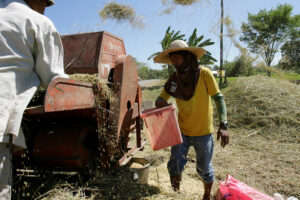PHL expected to import more rice due to El Niño
THE EL NIÑO weather event’s impact on agriculture production in the Philippines could lead to a surge in rice imports to account for the supply shortfall, the World Bank said.

By Luisa Maria Jacinta C. Jocson, Reporter
THE EL NIÑO weather event’s impact on agriculture production in the Philippines could lead to a surge in rice imports to account for the supply shortfall, the World Bank said.
“El Niño is expected to dampen farm production and increase the need for rice imports,” the multilateral lender said in its latest Food Security Update.
A strong El Niño is expected to continue until January next year and is seen to persist until May 2024, according to the latest advisory by the Philippine Atmospheric, Geophysical and Astronomical Services Administration (PAGASA).
The weather event increases the likelihood of below-normal rainfall conditions, which could bring dry spells and droughts in some areas of the country.
By the end of May 2024, 65 provinces are projected to experience a drought while six will face a dry spell.
The Philippines, one of the world’s biggest rice importers, will likely grapple with soaring prices of the staple.
The World Bank said global sugar and rice prices have increased by double-digits due to the El Niño and its impact on production and trade.
“El Niño has led to dry conditions in South and Southeast Asia, affecting sugar production in India and Thailand, the two largest exporters after Brazil,” it added.
Federation of Free Farmers Chairman Raul Q. Montemayor said that the El Niño will more likely affect the wet season harvest in the Philippines, which normally begins in the middle of the year.
“It could affect plantings for the next (wet season) crop which usually starts in May or June. There will be less rainfall in rainfed areas while irrigation dams may not be fully replenished and filled to capacity,” he said in a Viber message.
“This will result in delayed planting and/or reduced planted area. Crops may not survive if the drought lingers during the July-September lean months. The impact in terms of production will be felt when farmers harvest again in September-November,” he added.
The latest crop condition assessment by PAGASA showed that most of the provinces in Luzon received “inadequate amounts of water required to support both the rice and corn crops.”
Mr. Montemayor warned that securing imports may be difficult or expensive if other Southeast Asian countries like Thailand or Vietnam are also hit by the El Niño.
“Additionally, other countries that normally do not import but also want to ensure their food security through imports, such as Indonesia, will start competing with us for the available supply and this could drive up prices,” he said.
Rice imports have reached 3.22 million metric tons (MT) as of Dec. 7, according to the Bureau of Plant Industry.
The US Department of Agriculture is projecting rice imports to hit 3.8 million MT this year.
To address spiraling rice prices, the government earlier placed a temporary price cap on regular and well-milled rice from September to October this year.
The government should not just rely on imports as a stopgap measure and instead must provide further support to farmers and the agriculture sector, Mr. Montemayor said.
“Helping our farmers produce as much as possible despite less rainfall is the most important step. This would involve the rehabilitation of irrigation systems, water harvesting and impounding, and installation of irrigation pumps. This could be complemented by a public campaign to save water, reduce rice wastage, and promote rice substitutes,” he added.
The World Bank also noted other steps being taken by the Philippine government to ensure adequate rice supply, such as expediting rice importers’ clearances.
“In addition, a law has been proposed designed to minimize food waste and promote balanced eating habits by mandating that restaurants serve smaller-portioned, half-cup rice orders,” it added.














